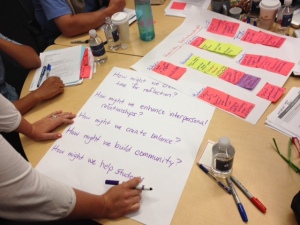What if faculty and staff viewed their individual and collective affinities through the lenses of learning and pedagogy rather than the silos of class, department, division, or office? What if faculty, staff, students, parents, and trustees engaged in strategic-level thinking together, on a frequent basis, collaboratively and transparently aligning school resources directly in support of our core learning goals? Is this a pipe dream? Where will we find the time? Can we really bust the silos of traditional interests in favor of system-wide support for learning-centered schools?
 Yes. I just finished two days of work with a leadership team at The Miami Valley School in Dayton. Our work started last fall with an all-hands day of imagining the future of the school, distilling the core passions of the collective faculty, staff and families that make the school unique and drive employees to want to work at the school, and students to attend.
Yes. I just finished two days of work with a leadership team at The Miami Valley School in Dayton. Our work started last fall with an all-hands day of imagining the future of the school, distilling the core passions of the collective faculty, staff and families that make the school unique and drive employees to want to work at the school, and students to attend.
Last winter, adopting work pioneered by my thought-friend Bo Adams of Mount Vernon Presbyterian School in Atlanta, I developed a format for educator-leaders to work sustainably in what I call “window teams”, rather than in their traditional silos of department, division, and office. Bo set the hook in my mind for this approach when he shared the idea of a “pedagogical master plan” that would layer and coordinate the key elements of great learning–pedagogy, assessment, leadership, communication, professional development, and more–just like architects design the blue print layers for a building or a campus. Bo and I presented this concept last winter at the NAIS conference in Orlando, and I used the “window team” concept to describe diverse groups of school stakeholders who would have authority and responsibility to design and coordinate the school vision through the “windows” of these key systems.
 The Miami Valley School decided to try this approach; Head of School Jay Scheurle and his team saw the importance of aligning to a common vision, unencumbered by the rigid boundaries of traditional silos. They saw that a true all-school vision will only evolve when we share a common North Star that guides our work, not separate and provincial interests that preserve fiefdoms of control, resources, and authority.
The Miami Valley School decided to try this approach; Head of School Jay Scheurle and his team saw the importance of aligning to a common vision, unencumbered by the rigid boundaries of traditional silos. They saw that a true all-school vision will only evolve when we share a common North Star that guides our work, not separate and provincial interests that preserve fiefdoms of control, resources, and authority.
Using a process rooted in design thinking, over the last two days the team built a powerful portfolio of ideas that align with the detailed school vision statement; gathered into window teams to investigate how the vision can be implemented when viewed through these windows that focus us on the systematic elements of great learning; focused on big ideas; designed action plans; practiced authentic and supportive feedback; and entertained each other with a wild session of creative storytelling to build capacity to communicate these bold ideas to the rest of the school community. During the process, the window teams found compelling synergy, and decided to coordinate their current efforts around the powerful and unique learning strategy that they call The Miami Valley Immersion Method.
The window teams will meet frequently during the year; they will engage larger groups of adults and students who share an interest or passion in each particular thread; they will increasingly become the foci of ongoing, evolutionary strategic level thinking and exchange at the school. Like those blueprint layers described by Bo, they will coordinate the layers of the MVS Immersion Method to ensure that it offers a powerful and sustainable learning experience for every student.
How will the window teams interface with the tactical work of departments and division leaders? Are the boundaries of authority too fuzzy, or will they evolve to be just right? Where is the boundary between window teams and board committees? What will the window teams focus on in 2015, 2016, and beyond? We did not answer every question; we trust the engaged stakeholders to think these through in the months to come. But the school has created the seeds of a powerful new framework that has the weight to finally bust through the silos that we all know are key obstacles to collaborative, vision-focused, connected, nimble, dynamic organizational evolution.



Leave A Comment